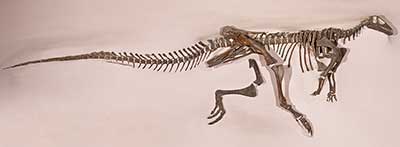Thescelosaurus
(thes-sel-oh-SORE-us)
| Quick Facts | |
|---|---|
| Name Meaning: | Marvelous lizard |
| Distribution: | North America |
| Time Period: | Late Cretaceous, 80 Ma - 65 Ma |
| Length: | 13 ft. (4 m) |
| Diet: | Herbivore |
| Habitat: | Near water |
| Linnaean Classification | |
| Kingdom: | Animalia |
| Phylum: | Chordata |
| Class: | Reptilia |
| Superorder: | Dinosauria |
| Order: | Ornithischia |
| Suborder: | Cerapoda |
| Infraorder: | Ornithopoda |
| Family: | Hypsilophodontidae |
| Subfamily: | Thescelosaurinae |
| Genus: | Thescelosaurus |
| Cladistic Classification | |
| |

History
The Thescelosaurus was discovered in 1891 by John Bell Hatcher and William H. Utterback, in Wyoming. However, this discovery remained stored until Charles W. Gilmore named them in 1913. Over the years several fragments were discovered but not much attention was given to them. In 1926 another well-preserved skeleton was found in the Horseshoe Canyon Formation in Alberta, Canada. Many well-preserved skeletons have been found indicating that the Thescelosaurus may have lived or been attracted to rivers, steams, and other forms of water where fossilization would have been more likely. In the year 2000 it was claimed that a specimen discovered in 1993 had a fossilized heart. Allthough the possibility is strong, this is somewhat doubted and solid evidence does not yet exist.Description
The Thescelosaurus was a bipedal dinosaur with a sturdy build, small wide hands, and a long pointed snout. It had bones above its eyes giving it large bony eyebrows. It had two types of teeth, small pointed teeth, and leaf-shaped teeth. Each hand had five fingers, and each foot had four toes. Each toe ended in a shape similar to a hoof. Its tail had ossified tendons that had slowly turned to bone on the back half of the tail, making it stiff. If the fossilized heart discovery of 1993 is genuine then the dinosaur had a high metabolism. It was not a tall dinosaur and probably browsed the ground selectively to find food. Its leg structure and proportionally heavy build suggests that it was not a fast runner like other dinosaurs.
ScienceViews Writer: Jason Hamilton.
Copyright © 2005-2010 Calvin & Rosanna Hamilton. All rights reserved.